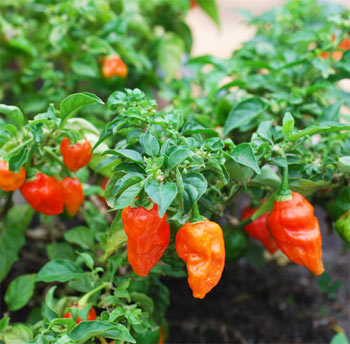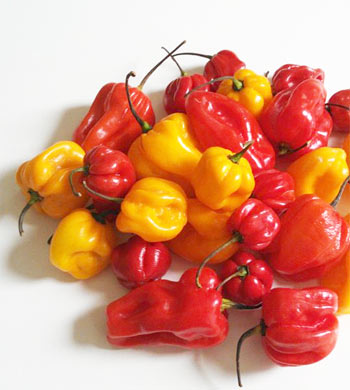7. Naga Bhut Jolokia

The Ghost Pepper (Bhut Jolokia), also known as Bhut Jolokia, ghost pepper, ghost chili pepper, red naga chilli, and ghost chilli. The Bhut Jolokia is an interspecific hybrid cultivated in the Indian states of Nagaland and Assam. It grows in the Indian states of Assam, Nagaland and Manipur. There was initially some confusion and disagreement about whether the Bhut was a Capsicum frutescens or a Capsicum chinense pepper, but DNA tests showed it to be an interspecies hybrid, mostly C. chinense with some C. frutescens genes.
In 2007, Guinness World Records certified that the Ghost Pepper (Bhut Jolokia) was the world’s hottest chili pepper, 400 times hotter than Tabasco sauce; however, in 2011 it was superseded by the Trinidad Moruga Scorpion.
The pepper is called by different names in different regions. North of the Brahmaputra, it is widely called Bhut Jolokia or Bhoot Jolokia, literally translating to ‘Ghost Chilli’ in Assamese and Bengali (“Bhoot” means ghost in most other Indo-Aryan languages as well). Some believe that “Bhut” might imply “from Bhutan” but that is incorrect as the translation of “from Bhutan” in Assamese is “Bhuitiya” not “Bhut”. Furthermore, this pepper has never occurred naturally in the temperate climate of Bhutan. On the southern bank of the river Brahmaputra, this chili becomes Naga jolokia, believed to be named after the ferocious Naga warriors inhabiting the plains & hills of Nagaland. Further complicating matters, a 2009 paper, published in the Asian Agri-History journal, coined the English term “Naga king chili” which refers to the chili’s large pod size. It also stated that the most common Indian (Assamese) usage is bhoot jolokia and gives the alternate common name as Bih Jolokia (bih means “poison” in Assamese, denoting the plant’s heat). The Assamese word “jolokia” simply means the Capsicum pepper. Other usages on the subcontinent are Saga Jolokia, Indian mystery chili, and Indian rough chili (after the chili’s rough skin). It has also been called the Tezpur chili after the Assamese city of Tezpur. In Manipur, the chili is called umorok or oo-morok (oo = “tree”, morok = “chili”).
Scoville rating
In 2000, India’s Defence Research Laboratory (DRL) reported a rating of 855,000 heat units (SHU) on the Scoville scale, and in 2004 a rating of 1,041,427 units was made using HPLC analysis. For comparison, Tabasco red pepper sauce rates at 2,500–5,000, and pure capsaicin (the chemical responsible for the pungency of pepper plants) rates at 16,000,000 SHU.
In 2005, at New Mexico State University Chile Pepper Institute near Las Cruces, New Mexico, regents Professor Paul Bosland found Bhut Jolokia grown from seed in southern New Mexico to have a Scoville rating of 1,001,304 SHU by HPLC. The effect of climate on the Scoville rating of Bhut Jolokia peppers is dramatic. A 2005 study comparing percentage availability of capsaicin and dihydrocapsaicin in Bhut Jolokia peppers grown in Tezpur (Assam) and Gwalior (Madhya Pradesh), India showed that the heat of the pepper is decreased by over 50% in Gwalior’s more arid climate. Elsewhere in India, scientists at Manipur University measured Bhut Jolokia’s average Scoville rating by HPLC at only 329,100 SHU.
Ripe peppers measure 60 to 85 mm (2.4 to 3.3 in) long and 25 to 30 mm (1.0 to 1.2 in) wide with a red, yellow, orange or chocolate color. The unselected strain of Bhut Jolokia from India is an extremely variable plant, with a wide range in fruit sizes and amount of fruit production per plant, and offers a huge potential for developing much better strains through selection in the future. Bhut Jolokia pods are unique among peppers, with their characteristic shape, and very thin skin. However, for the red fruit variety, there are two different fruit types, the rough, dented fruit and the smooth fruit. The images on this page show the smooth fruit form. The rough fruit plants are taller, with more fragile branches, and the smooth fruit plants yields more fruit, and is a more compact plant with sturdier branches.
In 2009, scientists at India’s Defence Research and Development Organisation announced plans to use the peppers in hand grenades, as a non lethal way to flush out terrorists from their hideouts and to control rioters. It will also be developed into pepper spray as a self-defense product.
R. B. Srivastava, the director of the Life Sciences Department at the New Delhi headquarters of India’s Defence Research and Development Organisation (who also led a defense research laboratory in Assam), said bhut jolokia-based aerosol sprays could be used by women as a “safety device”, and “civil variants” of chili grenades could be used to control and disperse mobs.
Dorset Naga
 Dorset Naga (Capsicum chinensis) is a subspecies of the original Naga, selected from the Bangladeshi varieties of the chili, naga morich. Annually, since 2005, the heat level of Dorset Naga has been tested, taking samples from different sites, various seasons and states of maturity. The heat level has ranged from 661,451 SHU for green fruit in 2007, up to 1,032,310 SHU for ripe fruit harvested in 2009. High as the results were, the BBC’s Gardeners’ World television programme recorded a much higher heat level for Dorset Naga. As part of the 2006 programming, the BBC gardening team ran a trial looking at several chili varieties, including Dorset Naga. Heat levels were tested by Warwick HRI and the Dorset Naga came in at 1,598,227 SHU, one of the hottest heat levels ever recorded for a chili.
Dorset Naga (Capsicum chinensis) is a subspecies of the original Naga, selected from the Bangladeshi varieties of the chili, naga morich. Annually, since 2005, the heat level of Dorset Naga has been tested, taking samples from different sites, various seasons and states of maturity. The heat level has ranged from 661,451 SHU for green fruit in 2007, up to 1,032,310 SHU for ripe fruit harvested in 2009. High as the results were, the BBC’s Gardeners’ World television programme recorded a much higher heat level for Dorset Naga. As part of the 2006 programming, the BBC gardening team ran a trial looking at several chili varieties, including Dorset Naga. Heat levels were tested by Warwick HRI and the Dorset Naga came in at 1,598,227 SHU, one of the hottest heat levels ever recorded for a chili.
Some plants have taken their self-defense up a notch. These plants, the chillies, use capsaicin, three times more potent than mustard oil. It is the most lethal chemical found in any human food source on earth. Less than 4g of this substance is enough to kill a large adult human. Although few chillies have such an amount, a small number have been cultivated specifically to increase their capsaicin content. Smaller amounts of capsaicin are often eaten by people in a variety of countries, and produce a tingling sensation in the mouth. The Naga Jolokia chilli, on the other hand, is a hybrid created in northern India which contains two hundred times more capsaicin than the hottest commercially available chillies. The amount of capsaicin is enough to disrupt neural processes, resulting in a signal of intense pain and heat being sent to the brain. To smell the air close to one of these chills is said to be like snorting fire, and can result in permanent anosmia. It cannot be touched with bare skin. It is used in India to deter elephants from farming areas simply by touching them on fences. It is important to note that the chillies themselves are not used, rather, anything they touch becomes so unpleasant to animals with good senses of smell that they give it a wide berth. In cooking, Naga Jolokia is seen as a challenge by many people, but even then it is only lightly touched on the food, as to actually include the chilli itself in a dish can result in death. The Indian military is currently planning on weaponizing it.
Disclaimer
The Content is not intended to be a substitute for professional medical advice, diagnosis, or treatment. Always seek the advice of your physician or other qualified health provider with any questions you may have regarding a medical condition.